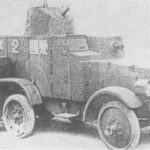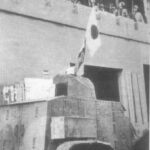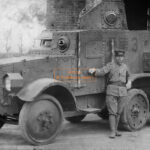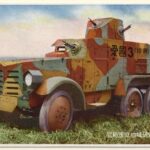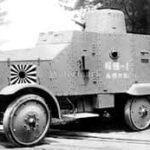With the kind correction of Mr Akira Takizawa (Taki)
We let Japan at the end of the twenties with foreign armored cars (Crossley) or with a combination of foreign chassis with Japanese bodies (Wolseley). But this was also time for the Japanese industry to produce complete domestic armored cars. Here again, the rivalty between Army and Navy led to specific models. It should be noted that this rivalty comes directly from the political events, the Navy focused on an empire over the seas like England and the Army focused on an empire over the lands (Korea, Manchuria and china). The intervention in Siberia (where Japan lost 5,000 dead) without achieving its objectives and finally retreated tore apart the unity of Japan, leading to opposition between the government and the army and factional fighting within the army itself. Tensions became untenable, favored by the 1929 economical crisis, and led to the assassination of Prime Minister Tsuyoshi in May 1932 and the seizure of power by the military. From this moment on, the military leaders decided on their own as to the intervention in Manchuria and favoured their own Army or Navy faction slowly but irrevocably bringing Japan to war. Japan did not develop any other serial armored car until 1945. The so called Osaka type 92 armored car was in fact a chinese armored car in Shanghai.
On the Japanese denomination of war materials, the situation is very complex because it refers to the years of reign of the different emperors: Meiji (1867 to 1912), Taisho (1912 to 1926), Hirohito (1926 to 1989). As far as we are concerned, the armored cars were produced during the reign of Emperor Hirohito, but for this period, the year used is that of the Japanese calendar which is 660 years ahead of the Western calendar, so , type 90 corresponds to the year 2590 which makes 1930 for Westerners. We will therefore find the designation type 90. Note that the word “type” is the reference for the year of production, so we can find several vehicles totally different called type 92 for example.
1 – The IJA armored cars :
The chiyoda armored car :
The Chiyoda Armored Car was the first domestic Japanese armored car which was officially introduced by the IJA only and used in numbers. Around 200 are claimed to have been produced although their rarity in the photos may demonstrate the contrary. Design started in 1930, development was finished in 1931 and the vehicle was officially adopted as the “Chiyoda Armoured Car” with production in 1932 by TGE (Tokyo Gas and Electric Industries Co ) now hino motors. based on their Type Q 6-wheeled truck under the development designation “Type QSW”.
According to known data, the motor was also designed by TGE. It also used solid rubber tires instead of pneumatic tires.
All Chiyoda Armored Car photos also indicate a tri-color camouflage pattern applied to the vehicles. These do not include the separating black contrast lines or stark yellow lines seen on some early Japanese tanks, but rather are a simpler combination of subtle beige. brown and green.
Around 200 Chiyoda Armoured Cars were apparently produced (although only six armored cars could be proven by photos) and used during early and mid 1930s IJA operations in Manchuria for infantry support and security duties.
The Chiyoda Armored Cars were effectively replaced in most of their roles after 1937 by the Type97 Tankette Te-Ke. Use of the 6-wheel road-going armored cars overall seems to have declined after the spike in production of the Chiyoda armored cars, however, with most use of the Sumida armored cars on rail in China. Perhaps this is due to the Japanese needing to move deeper into rural China where good roads became scarce, and into the Pacific islands, both places where tracked light tanks and tankettes would fare better. For obvious reasons, armored cars were infrequently used or seen on previously uninhabited or road-free Pacific Islands, though they were used in the Philippines on rail.
Data:
Vehicles built: approx. 200 (pobably far less)
Battle weight: 5.6 t
Crew: 5 men
Armor: Up to 6 mm
Length: 5000 mm
Width: 1900 mm
Height: 2600 mm
Engine: 4 cylinder gasoline
Power: 75 hp
Maximum speed: 60 km/h
Power/weight ratio: 13.4 hp/t
Armament: 3 X Type Taisho 11 6.5 mm MG, later 3 X Type 91 6.5 mm Tank MG
Chiyoda Armored Car (IJA)
The Sumida Type RSW Railcar:
In the late 1920th IJA ordered Ishikawajima´s factory to develop a special armored car for railway use. Main purposes should be guard duty, transport, towing of small wagons and armored reconnaissance. The development started under the internal designation RSW using an own 4X2 truck chassis.
The armor consisted of 6 mm face-hardened steel plates riveted to a frame. The armor was mainly arranged vertical with only the upper engine cowling and the driver cabin´s frontal armor arranged sloped. A large cylindrical rotating turret was mounted on the top. There was no fixed armament installed but it was possible to mount the standard light MGs issued to the railway regiments. The MGs could be mounted in several MG ports on each side of the vehicle and the turret.
The suspension was powered by standard gasoline truck engine and transmission. Due to its limited power the heavy vehicle was underpowered and there was just one reverse gear limiting the reverse speed. Road usage was not possible limiting the operational possibilities.
At least one vehicle was produced and tested 1929 in Manchuria. There was a little serial production. The whole concept was rated useful even with its several design problems and led to the type 91 Sumida So-Mo. One can still note some differences between the photos (hatch is square or round, different camouflages) suggesting different cars.
Sumida Type RSW Armored Railcar
The Type 91 Sumida So-Mo armored car :
In 1916, a company named Ishikawajima Shipbuilding & Engineering Co., Ltd. (dating from 1889) started an automobile project. An agreement was reached with the British company Wolseley in 1918. The exclusive right to manufacture and distribute Wolseley cars in East Asia was also obtained. This was the first so-called « technical assistance » contract between Japan and the West for the construction of an automobile. In 1922, the first passenger car manufactured in Japan, the Wolseley A9, appeared, and later the first truck named 1.5-ton CP was built. In 1927, Ishikawajima decided to stop the collaboration with Wolseley (while 550 A9 and CP trucks had been produced) to manufacture its own vehicles. Ishikawajima produced both military and civilian vehicles under the name Sumida. It should be noted that another company TGE ( Tokyo Gas and Electric Industries Co) also produced military and civilian vehicles under the name Chiyoda. These vehicles were equipped with the new A4 and A6 gasoline engines (first Japanese gasoline engines). It should be noted that Ishikawajima and Tokyo Gas and Electric Industries Co merged in 1937, Isuzu beeing the name of new company’s vehicles.
In 1930, the first self-made Japanese armored car was produced, which was rather an armored truck under the name Sumida P by Ishikawajima. This vehicle was mainly used by the landing forces of the Japanese Imperial Navy. We must not forget the incessant struggle for influence between the army and the navy, which also had its own land forces (landing forces like the US marines).
In September 1931 the invasion of Manchuria began, and in these vast expanses devoid of any road network, rail was of paramount importance just as in Russia. Originally equipped with armored trains, the need was quickly felt to have lighter and more responsive vehicles. Note that the reflection was the same in Russia. In addition, the envisaged threats could be supported by this type of vehicle even light. A first prototype was asked to Ishikawajima because this firm had the necessary experience, it was the Sumida type RSW (four wheels) which was deployed in Manchuria. Then the same company proposed to upgrade its Sumida P to develop a mixed rail / road version under the name Ishikawajima PA-type tractor. It was that version (PA) that was later produced by TGE under the name type 91 So-Mo. In 1933, a small modification made it possible to use a fixed machine-gun in turret. Note that the name armored car is flattering, the Japanese themselves call the types 91 « rail tractors for wide track ». On type 91, there was no fixed machine gun in turret because the army reserved the fixed weapons for the infantry, the artillery and the cavalry, the type 91 being considered as railway vehicle, only the weapons of the soldiers on board were used.
On the Japanese name of military vehicles, the situation is very complex because it refers to the reign years of different emperors: Meiji (1867 to 1912), Taisho (1912 to 1926), Hirohito (1926 to 1989). As far as we are concerned, the vehicles were produced during the reign of Emperor Hirohito, but for this period, the year used is that of the Japanese calendar which is 660 years ahead of the western calendar, So, type 91 corresponds to the year 2591 which makes for the Westerners 1931. We thus find the appellation type 91 or type 2591. Note that the word « type » is the reference of the year of production, so we can find several totally different vehicles called type 92 for example.
The change of the road / rail wheels was done by removing the full tires or metal bandages and storing them on the sides. For this, the vehicle was lifted via four jacks attached to the front and rear. Normally, it lasted 10 to 20 minutes for the maneuver. The width of the track was not a problem because the spacing could be adapted according to, in fact, the spacing in Manchuria or China (wider 1435 mm) and Japan (narrower 1372 mm) was not the same. The speed ranged from 40 km/h on the road to 60 km/h on rail. With the invasion of China in 1937, these vehicles proved their usefulness in monitoring the rail network. Since the vehicle was based on a truck chassis, it only had one speed in reverse, which required it to drive slowly in the event of a recoil, which is why two vehicles were often coupled at the rear in order to move quickly. in both ways. To improve this defect, the type 92 was developed, it had a gear to reverse the rotation. These vehicles were used in China, Malaya, Burma and Manchuria. The crew consisted of six men and a 6.5 mm or 7.7 mm machine gun. The 16mm shield was sufficient for the type of threats encountered. Note that the production number of 1000 usually used seems very exaggerated compared to the usual Japanese production especially for this type of very particular vehicle and in regards of the needs.It should also be noted that later in the war, when the gas supply will be more difficult, a gas generator kit will be added to the front left of the vehicle.
Characteristics :
Production year: 1931/1933
number: about 1000 (probably exaggerated)
weight: 7.7 t
length: 6.57 m
width: 1.9 m
height: 2.95 m
crew: 6
armor: from 8 mm to 16 mm
armament: 1 machine gun 6.5 mm or 7.7 mm
engine: 4 cyl gasoline of 45 HP
range: 241 km
speed: 40 km/h on the road / 60 km/h on the rail
Type 91 Sumida So-Mo armored car (IJA)
2 – The IJN armored cars:
The Sumida P armored car:
In 1930 was produced the first purely Japanese armored car which was more like an armored truck, under the name Sumida P by Ishikawajima. This vehicle was only used by the landing forces of the Imperial Japanese Navy (SNLF: Special Naval Landing Forces). We must not forget the ceaseless struggle for influence between the Army (IJA: Imperial Japan Army) and the Navy (IJN: Imperial Japan Navy) which also had its own land forces (landing forces identical to the American Marines) . This version was on the other hand intended only for the road contrary to the version of the Army (IJA) type 91 So-Mo which could be adapted for the rail. This vehicle was manufactured in three copies, There are few photos, there are markings 1 and 3 only and there is a photo on which we see the three together. Contrary to the later version type 91, the Sumida model P armored car carried fixed weapons and was provided with ball joints or hatches for machine guns (type 11 light machine gun) or rifles. It was therefore a vehicle very suitable for urban combat, on the other hand, off the roads, it had to be unusable with its narrow wheels with solid tires.
In Japan as in other countries, the populations could finance the construction of vehicles for the Army or the Navy, vehicles received the nicknames of Hokoku for the Navy and Aikoku for the Army. This is what we see as an inscription on the sides of the body, it is also why this vehicle is sometimes incorrectly referred to as the Hokoku type. Vehicle No.1 was funded by the city of Nagaoka.
These vehicles were received by the navy in July 1932 so too late to participate in the first incident in Shanghai, but some photos show some vehicles in action during the second battle of Shanghai in 1937. These vehicles were part of the SNLF Shanghai Special Naval Landing Corps armored company (the armored cars consisted of the 9 M25 Vickers Crossley purchased by the Navy and 3 Sumida Model P armored cars). Commanded by Rear Admiral Ohkochi and subordinate to Vice Admiral Hasegawa, Commander of the 3rd Fleet and Supreme Commander in Shanghai, the corps before the battle of 1937 consisted of 2,500 men (including Hankou’s detachment of 300 men). The corps included a staff battalion and six naval infantry battalions including the 4th artillery (4 x 150 mm howitzers, 4 x 120 mm howitzers, 12 x 75 mm mountain guns, 4 x 70 mm infantry guns, 4 x 20 mm anti-aircraft guns, 8 x heavy mortars 150 mm). The armored company (which in 1932 included only 9 M25 Vickers Crossley armored cars) was reinforced after 1932 with 4 medium tanks type 89 (1 type A early, 3 type A late), 3 Sumida P armored cars, 3 naval type 93 armored cars, 4 Carden loyd VIb light tanks. This new armored detachment was commanded by Lt. Yoshino Shozo. Regarding the color, the vehicles were all khaki and never gray. The uniform which until then had been that of the navy (dark blue in winter, white in summer) also evolved after 1932 to adopt a less showy outfit, green close to that of the army. These three vehicles were still in Shanghai in August 1945.
Sumida P Armored Car (IJN)
The Type 93 naval armored car:
The invasion of Manchuria in September 1931 marked the beginning of Japanese territorial expansion in Asia. Being an island like England, Japan had to rely as much on its army as on its navy. This is why it took, as in England, a preponderant place in the Japanese military environment. In the late 1920s, the Imperial Japanese Navy acquired independent marine landing troops, until then each ship had its own detachments with basic training. The size of a battalion, these troops (SNLF or special naval landing forces) were raised and took the name of the four main naval districts or bases in Japan: Kure, Maizuru, Sasebo, Yokosuka. Quite quickly the need arose to provide these troops with armored support for future combat. Exacerbated competition with the army prevented any common development of a combat vehicle and this is how the imperial Japanese navy ordered a first armored vehicle for its troops, in this case, the Sumida P armored car. The three vehicles built were delivered to the armored company of the SNLF Shanghai guard detachment and engaged in the Shanghai incident in 1932. The lessons of his engagement (one of the three was seriously damaged) led the navy to seek a more powerful vehicle and better adapted to urban combat. It was the Type 93 Naval Armored car. It is sometimes called type 92 (year of design – 2592 for Japan) but its official designation is type 93 (year of reception by the navy – 2593 for Japan).
This Armored car designed in 1932 by Ishikawajima Heavy Industries specifically for the Imperial Navy (IJN), was probably based on a western chassis (the driver’s cab is unusually on the left) may be Ford.
It was delivered to the navy in 1933, after the first incident of Shanghai (1932) and participated in the second battle of Shanghai in 1937. The production was probably three vehicles, some sources state five but we never see any more than three on vintage photos. At the end of the war, the three were still listed in possession of the Shanghai Navy Special Corps.
Drawing lessons from urban combat, it was more powerful and better adapted than the Sumida P. If the design is classic, engine at the front, combat compartment in the center and circular turret, other elements were innovative, the roof of the body was tilted on its four sides so as to cause any grenades to fall to the ground. In the same way, the front face of the turret was very inclined so as to be able to fire the machine gun at strong angles upwards from the buildings. Because there was a large distance between the front and rear wheels, additional metal wheels were attached freely behind the front wheels to improve performance in rough terrain. The tires were not full but pneumatic. A machine gun on an external support was attached to the rear of the turret not for anti-aircraft defense (almost non-existent) but to provide greater firepower in urban combat in order to reach the floors of the buildings. The vehicle apparently proved itself during the second battle of Shanghai in 1937
Contrary to certain sources, this vehicle was not suitable for railway life. Note that the name « kokusan » sometimes used simply means made in Japan, the other names « Aikoku » and « Hokoku » characterize vehicles donated for the Army or Navy.
Characteristics :
Year: 1933
Weight: 6,8 t
Dimensions: length: 4.80 m / width: 1.80 m / height: 2.30 m
Armor: 4 mm (roof) / 8 mm (sides) / 11 mm (front)
speed: 40 km / h
Armaments: 1 x Vickers 7.7mm MG, 4 x Type 11 6.5mm
Crew: 4
Production: 3 to 5 (depending on sources)

